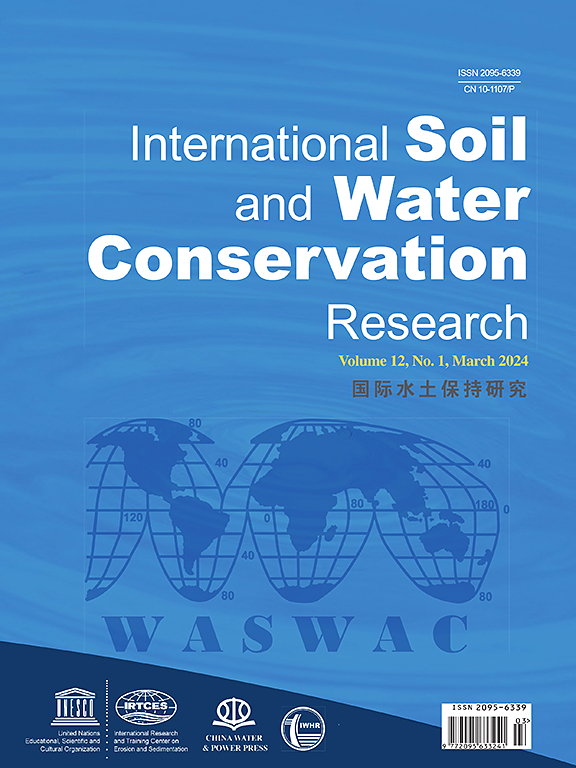Evaluation of the effectiveness of an expressway sand protection system in a gobi region—case study of the Ceke–Ejina expressway, Ejina banner, China
IF 7.3
1区 农林科学
Q1 ENVIRONMENTAL SCIENCES
International Soil and Water Conservation Research
Pub Date : 2024-10-04
DOI:10.1016/j.iswcr.2024.09.003
引用次数: 0
Abstract
Sand protection systems are widely used to shelter roads from blowing sand. Therefore, it's very important to evaluate their effectiveness. To provide some insights, we used field investigations, measurements of accumulated sand, work logs from sand-removal workers, and wind speed data to analyze a system's performance using China's Ceke–Ejina expressway as a case study. Our results demonstrated that the critical wind speed required to deposit sand on the expressway was 8.6 m s-1 (cumulative frequency 12.1%) before implementing the sand protection system. After implementing the system, the critical wind speed required to deposit sand on the road increased to 14.8 m s-1 (0.3%). However, the critical wind speed decreased to 11.1 m s-1 (3.5%) the next year. Additional work, such as digging ditches, increasing the fence height, and planting shrubs, would help the sand protection system retain its function. Nonetheless, the system continued to function well. The volume of sand removed decreased from ca. 10,000 m3 in 2015 to ca. 100 m3 in 2020. Our results quantify the effectiveness of the sand protection system and reveal how its effectiveness decreases over time. They therefore provide an empirical basis for improving the design and maintenance of sand protection systems.
戈壁滩地区高速公路防沙系统效果评价——以额济纳旗契克-额济纳高速公路为例
防沙系统被广泛用于保护道路免受风沙的侵害。因此,评估它们的有效性是非常重要的。为了提供一些见解,我们使用了现场调查、积沙测量、清沙工人的工作日志和风速数据来分析系统的性能,并以中国的Ceke-Ejina高速公路为例进行了研究。结果表明:高速公路防沙系统实施前,防沙所需的临界风速为8.6 m s-1(累积频率为12.1%);实施该系统后,道路上堆积沙子所需的临界风速增加到14.8 m s-1(0.3%)。但第二年的临界风速降至11.1 m s-1(3.5%)。额外的工作,如挖沟,增加围栏高度,种植灌木,将有助于防沙系统保持其功能。尽管如此,这一体系继续运转良好。出砂量从2015年的约10000立方米减少到2020年的约100立方米。我们的研究结果量化了防砂系统的有效性,并揭示了其有效性如何随着时间的推移而降低。因此,它们为改进防砂系统的设计和维护提供了经验依据。
本文章由计算机程序翻译,如有差异,请以英文原文为准。
求助全文
约1分钟内获得全文
求助全文
来源期刊

International Soil and Water Conservation Research
Agricultural and Biological Sciences-Agronomy and Crop Science
CiteScore
12.00
自引率
3.10%
发文量
171
审稿时长
49 days
期刊介绍:
The International Soil and Water Conservation Research (ISWCR), the official journal of World Association of Soil and Water Conservation (WASWAC) http://www.waswac.org, is a multidisciplinary journal of soil and water conservation research, practice, policy, and perspectives. It aims to disseminate new knowledge and promote the practice of soil and water conservation.
The scope of International Soil and Water Conservation Research includes research, strategies, and technologies for prediction, prevention, and protection of soil and water resources. It deals with identification, characterization, and modeling; dynamic monitoring and evaluation; assessment and management of conservation practice and creation and implementation of quality standards.
Examples of appropriate topical areas include (but are not limited to):
• Conservation models, tools, and technologies
• Conservation agricultural
• Soil health resources, indicators, assessment, and management
• Land degradation
• Sustainable development
• Soil erosion and its control
• Soil erosion processes
• Water resources assessment and management
• Watershed management
• Soil erosion models
• Literature review on topics related soil and water conservation research
 求助内容:
求助内容: 应助结果提醒方式:
应助结果提醒方式:


